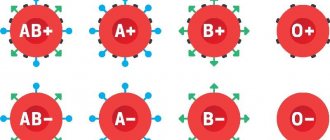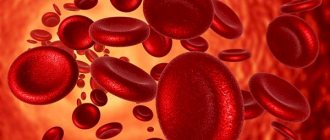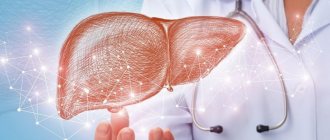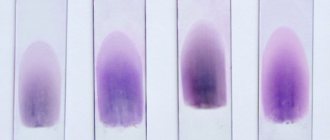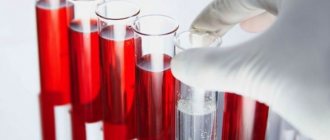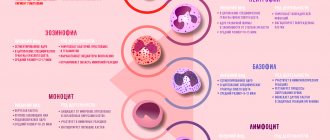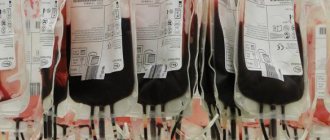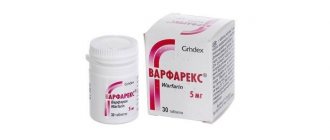Editor: Andriyanov G.Yu., general practitioner, Ph.D. April, 2019.
Synonyms: hematocrit, hematocrit number, hematocrit value, Ht, Hct, Hematocrit.
The hematocrit number is the ratio of the red blood cell volume to the liquid amount of blood (i.e., the ratio of the volume of red blood cells to plasma). The determination of this indicator is included in the mandatory list for determining other indicators in a general blood test (CBC). Hematocrit measurement is not performed separately.
The hematocrit value is used to judge the thickness of the blood and its ability to transport oxygen.
Photo: with a decrease in hematocrit value, the ratio of red blood cells to plasma volume decreases
Hematocrit - what is it, what does it depend on
Hematocrit analysis provides data on the ratio of the volume of red blood cells to the total volume of blood; sometimes this indicator refers to the ratio of the volume of all formed elements to the total volume. There is no particular difference between the interpretations; 99% of the blood cell volume is made up of red cells. More often, hematocrit is recorded as a percentage of the total volume, less often as a ratio of cell volume to total blood volume.
This indicator is determined as part of a general blood test complex. It is classified as secondary and is calculated based on data on the number of red blood cells. Occasionally, direct measurement of hematocrit is performed by centrifuging the sample. This procedure allows you to separate plasma from formed elements and directly measure this indicator.
Reasons for increasing hematocrit
Dehydration (dehydration). Loss of fluid due to repeated vomiting and/or diarrhea, sunstroke, burn disease, pathology of the digestive tract, intestinal obstruction, hyperhidrosis (excessive sweating), peritonitis leads to blood thickening due to an unchanged number of red blood cells.
Hypoxia. People suffering from diabetes, smokers, people located high in the mountains or in unventilated areas experience a lack of oxygen, which leads to the release of red blood cells into the bloodstream.
Cardiovascular pathology. Heart defects, coronary disease, and cardiovascular failure are accompanied by a lack of oxygen in the blood.
Bronchopulmonary pathology. Chronic hypoxia leads to: bronchial asthma, emphysema, obstructive bronchitis and other pulmonary diseases.
Neoplasms in the kidneys. Any kidney tumor provokes increased production of erythropoietin, which increases the formation of red blood cells.
Erythrocytosis. The pathology is characterized by increased production of red cells (true erythrocytosis) or redistribution of formed blood elements in some diseases (redistribution).
Erythremia. Refers to true erythrocytosis, synonymous with Vaquez-Osler disease. It is one of the variants of chronic leukemia.
Leukemia. Accompanied by an increase in white blood cells and a decrease in its liquid part.
Indications and preparation for analysis
Indications for hematocrit analysis are symptoms indicating the development of anemia or other diseases of the blood or hematopoietic system. These include:
- Pale or jaundiced skin
- Enlarged spleen, liver
- Changes in the size of lymph nodes
- Digestive disorders
- Skin and hair problems (rashes, ulcers on mucous membranes, hair loss or brittleness)
In addition to identifying anemia, the analysis allows us to identify other diseases, for example, polycythemia (a chronic disease in which the bone marrow produces an excess amount of red blood cells) of various origins. This study is also used when it is necessary to assess the need for blood transfusion and calculate the required volume of transfusion.
No special preparation is required for the hematocrit test. It is necessary to follow the standard rules for conducting a general blood test:
- Blood is drawn early in the morning.
- You should not eat food 6-10 hours before the test.
- Avoid alcohol 2-3 days before the procedure.
Patients who smoke are advised to abstain from smoking for at least 2-3 hours before blood collection. If these recommendations are not followed, the analysis may give unreliable results. This is due to the fact that the composition of the blood is subject to strong fluctuations depending on the action of various environmental factors.
Hematocrit norms
Hematocrit values depend on age, as well as gender (in adults).
Important! Standards may vary depending on the reagents and equipment used in each particular laboratory.
That is why, when interpreting the results, it is necessary to use the standards adopted in the laboratory where the analysis was carried out. You also need to pay attention to the units of measurement. Generalized standards adopted in Russia are given in the table:
Western medical literature provides more general reference values:
- Men - 0.40-0.54 / 40-54%
- Women - 0.36-0.46 / 36-46%
- Newborns - 0.53-0.69 / 53-69%
Factors influencing the result:
Hematocrit increases against the background
- stress,
- taking corticosteroid drugs and diuretics,
- traumatic shock accompanied by intense pain.
A decrease in hematocrit is facilitated by:
- prolonged immobility;
- taking blood thinners (disaggregants, anticoagulants);
- high fluid intake;
- chronic alcoholism.
Important! The interpretation of the results is always carried out comprehensively. It is impossible to make an accurate diagnosis based on only one analysis.
Blood test for hematocrit
The manipulation is performed in the morning, blood is taken from a vein or from a finger. At the Medart clinic, the most modern equipment is used for analysis, so the sampling is most often done from a vein.
To obtain the material, special vacuum containers (vacutainers) are used. This is a modern syringe replacement that provides a number of benefits for the patient:
- Virtually painless procedure.
- Minimum time to obtain the required amount of blood.
- Accurate calculation of the amount of reagent and blood.
- Minimum time for conducting the study and issuing results to the patient.
Modern technologies allow the procedure to be carried out as quickly as possible, without consequences for health.
Laboratory microscopy
Calculation of the hematocrit number is included in the general clinical blood test. A separate study of this indicator may be prescribed in case of unsatisfactory results of OKA: anemia (anemia) and high concentration of red blood cells, as well as in case of bleeding of various etiologies (origins), in case of dehydration (dehydration) of the body. HCT is an important indicator of chronic hematological diseases.
To obtain objective final data, on the eve of the study, the patient is recommended to eliminate heavy foods (fatty and fried foods) from the diet, eliminate alcohol-containing drinks, and limit sports and other physical activities. The blood sampling procedure is carried out in laboratory conditions, in the morning.
Before the analysis, it is advisable to give up breakfast and smoking. The hematocrit value is determined using a laboratory device into which a glass graduated tube containing the blood sample being tested is placed. An anti-clotting agent is first added to the biofluid.
Under the influence of centrifugal forces (centrifugation), the blood is stratified. Red blood cells precipitate, clearly demonstrating their volume, and the plasma rises to the top. The remaining formed elements (leukocytes and platelets) are concentrated between them.
Brief scheme for hematocrit allocation
In modern laboratories, the process of measuring red blood cell volume is fully automated. The measurement value of hematocrit in clinical microscopy is taken as percentages or units (% multiplied by a factor of 0.01).
Norms
The normal hematocrit level depends on the age and gender of the person. For a mature woman it is 37-50%, for a man 34-45%. For newborns, this figure may be higher and ranges from 35 to 65%. As people grow older, the hematocrit decreases, reaching minimal levels in the elderly. This is the result of decreased bone marrow activity and decreased production of blood cellular elements.
A decrease in normal hematocrit in women is associated with regular blood loss during menstruation. High values in children are a manifestation of active processes in the development of red bone marrow and other hematopoietic organs.
It is important to consider that after massive blood losses and blood transfusions, determining the hematocrit level will give results with a large error. To reliably assess this indicator in such cases, it is necessary to wait a certain time.
It may take up to 3 months for complete physiological restoration of red blood cell levels to normal levels. This period is the life cycle of red blood cells, during which the cellular composition of the blood is renewed.
Hematocrit number
The hemorrhage value reflects the degree of saturation of the blood with red blood cells and their performance. Red blood cells act as a conductor of oxygen from the lungs to body tissues and carbon dioxide in the opposite direction. This is their main function. In addition, red blood cells are responsible for the delivery of vitamins, amino acids, cholesterol and glucose from the digestive system to cells.
Take part in:
- in maintaining the constancy of the internal environment of the body (homeostasis) and the processes of adaptation to biological changes;
- in nutrient metabolic processes;
- in protecting blood vessels from the negative effects of free radicals.
The hematocrit level shows how much the blood is filled with red cells to ensure the full functioning of the body.
Hematocrit increased
An increase in the level of red blood cells detected in a hematocrit analysis may indicate various pathological conditions. The most common:
- Primary erythrocytosis. It occurs as a result of overactive production of red blood cells, including immature forms. May indicate the development of tumors in the bone marrow.
- Secondary erythrocytosis. Develops as a consequence of pathologies of the respiratory and cardiovascular systems (heart defects, respiratory failure).
- Reduced plasma volume. May indicate the development of peritonitis, leukemia, kidney disease. Often occurs with extensive burns, when blood plasma sweats through the damaged dermis.
- Dehydration. Observed in uncompensated diabetes mellitus, it can result from diarrhea, vomiting, excessive sweating and lack of fluid in the diet.
Erythrocytosis can develop in heavy smokers, especially if smoking has led to secondary damage to the respiratory system and heart. In this case, the body turns on mechanisms to compensate for insufficient oxygenation due to a significant increase in the number of red cells.
An increase in hematocrit is not always a consequence of disease. An increase in the number of red blood cells is considered normal for residents of mountainous areas and professional climbers. When exposed to high altitude conditions for a sufficiently long time, the body compensates for the lack of oxygen and atmospheric pressure by increasing the production of red blood cells.
Erythrocytosis is often asymptomatic and is discovered by chance during a blood test for other reasons. Only with a significant increase in hematocrit are the following observed:
- Pain in joints, muscles.
- Dyspnea.
- High blood pressure.
- Ringing in the ears and dizziness.
- Increased sweating, sleep disturbances.
These symptoms are not specific, so if such ailments occur, you should consult a doctor for further diagnosis.
To restore the physiological level of hematocrit, it is necessary to find out the reason that led to an increase in the amount of blood cells and eliminate it. For example, if erythrocytosis was caused by dehydration (lack of water in the body - dehydration), it is enough to restore the normal amount of fluid to normalize this indicator.
There is no need to self-medicate; only a specialist can accurately determine the cause of the increase in hematocrit and prescribe the correct diagnosis and treatment. Therefore, if there are any changes in the blood test, you should consult a specialist and strictly follow the recommendations received.
Reasons for decreased hematocrit
Gestational period. Starting from the second trimester, the volume of circulating blood increases, but the number of red blood cells does not change.
Overhydration. Intravenous massive infusions lead to an increase in the volume of circulating blood, that is, to dilution of the blood, while the number of red blood cells remains the same.
Anemia of various origins. The lack of red blood cells naturally affects hematocrit values.
Intensive destruction of red blood cells. Occurs in the presence of hemolytic anemia of hereditary or acquired origin, in case of poisoning with hemolytic toxins (salts of heavy metals, consumption of toadstool) or serious infectious diseases (malaria, typhoid fever).
Blood loss (internal or external bleeding). Replenishment of circulating blood volume can be done quickly with crystalline or colloidal solutions. Restoration of lost red blood cells occurs only after a certain time or through blood transfusion.
Hyperproteinemia (increased total protein in the blood). This condition is observed in myeloma, lymphogranulomatosis, paraprotienemic hematoblastoses, diarrhea and vomiting. Excess protein in the blood draws fluids from the body into the bloodstream, increasing the volume of circulating blood while maintaining the same number of red blood cells.
A disorder of the formation of new red blood cells in the bone marrow. May be caused by blood diseases (anemia, leukemia), taking cytostatics and antitumor drugs, and renal paresis.
Tactics depending on the degree of reduction in the indicator:
- A decrease in hematocrit in the range of 35-30% requires outpatient observation by a doctor and changes in diet (increase consumption of meat, leafy greens, liver).
- When the hematocrit value decreases to 29-24%, iron supplements, B vitamins and folic acid are prescribed.
- If the rate drops to 13% or less, the condition is considered extremely serious and requires emergency hospitalization.
When the hematocrit decreases and anemia is detected in people over 65 years of age, the examination should be more thorough, since anemia in old age often accompanies serious diseases, for example, renal failure, hypo- or hyperthyroidism.
Results
The hematocrit value (HCT) is a reflection of the red blood cells (RBCs) in the blood relative to the plasma. The hematocrit level is determined as part of a general clinical blood test. HCT laboratory standards are developed taking into account the age and gender of the individual.
Women's normative values are lower than men's, which is associated with monthly blood loss. The upper limit of HCT for women of reproductive age is 45%. With the onset of the premenopausal period and during menopause, the norm increases to 47%. During the perinatal period, the hematocrit number decreases due to thinning of the pregnant woman's blood. For men under 45 years of age, the reference value is 39–49%, for men over 45 years of age, 49–50%.
The reasons for the increase in the indicator are:
- chronic pathologies of the cardiovascular system and respiratory organs;
- dehydration of the body;
- oxygen deficiency due to smoking or intense sports training.
A decrease in hematocrit number, first of all, indicates anemia (anemia). Children's values increase as they grow older. In newborns, the level is elevated due to changes in living conditions. A pathologically high rate is recorded during oxygen starvation (hypoxia) of the baby during birth. If there are systematic deviations of hematocrit, hemoglobin and red blood cells from the reference values, the patient needs advanced laboratory and hardware diagnostics.
Reference values
The volume of red blood cells in the body is not a constant value, so the hematocrit depends on the following conditions:
- patient's gender;
- age category;
- chronic pathologies.
Temporary conditions of the body (pregnancy, infectious viral diseases, physical overload) are of no small importance. A change in the hematocrit number indicates the density (level of concentration) of the blood. In women, the standard values are lower than in men, since due to physiological characteristics the blood is renewed more often. In addition, the total amount of fluid in the body decreases with age, so children's HCT changes as they get older.
HCT reference values for adults
| Floor | Men | Women | ||
| Age | 18–45 | 45+ | 18–45 | 45+ |
| Norm (%) | 39–49 | 40–50 | 35–45 | 35–47 |
Reference! The average hematocrit for a healthy adult is 40–45% of the total volume of biological fluid.
The maximum permissible upper limit is 50%, the lower limit is 35%. The liquid part of the blood, accordingly, should not occupy less than 50% and more than 65%. When hematocrit values are less than 35%, as a rule, diet correction and systematic monitoring of TCA indicators are prescribed. A decrease in HCT by up to 25% is compensated not only by diet therapy, but also by taking medications. The patient's condition requiring hospital treatment is determined by a hematocrit value of less than 20%.
Normal children's indicators
Children's HCT norm is determined according to age category. Indicators approach adult values at puberty. Standard indicators for children and adolescents:
| Age | Newborn | Infants up to one year old | 1–5 years | 6–11 years | Puberty | |
| Boys | Girls | |||||
| Norm (%) | 33–65 | 33–44 | 32–41 | 33–41 | 35–45 | 34–44 |
Depending on the laboratory conducting the research, standards for children may have a more detailed gradation by age.
The high level of hematocrit in a newborn baby is explained by the transition from the intrauterine state, when the baby is in the amniotic fluid, to a full life (outside the liquid environment).


